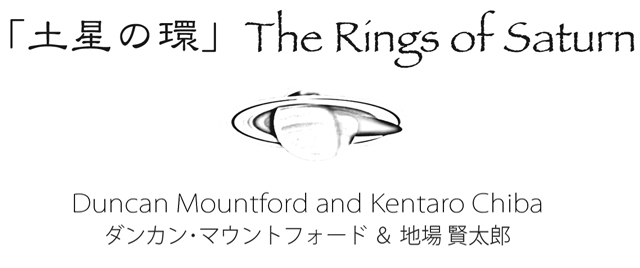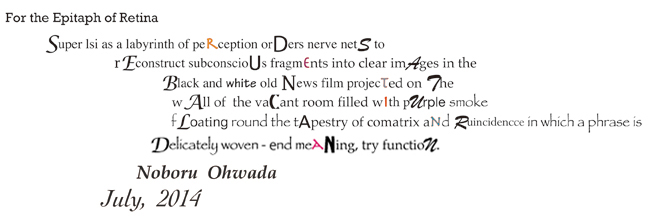September 1 - 13 2014
Hours : 14:00-20:00
Reception : September 1, 18:00-20:00
Location : Art Lab Akiba
What We See in the Dark
The Scientific Revolution of the 17th century literally transformed our vision of the world. Our eye became opened to new macrocosms and microcosms with the dawn of the telescope and microscope, advancing a new age of observation of our world and its place in the universe, distilling a distinct sense of “objectivity” which set us upon an isolated island from the space and phenomenon around us. It was in such an age that Thomas Browne was born, the great multi-disciplinary writer and doctor who crossed numerous fields in his work. He placed a new lens to creation, combining scientific speculation with mystic musings, offering up a radical new world view, exemplified by the “Eternal Present” in which everywhere and everytime simultaneously coexist in one point. And it is this vision which W.G. Sebald pursues in “Rings of Saturn”, paying homage to Browne’s form of divine eye. Sebald’s seminal work is itself a kaleidoscope of times, geographies, events and memories which disturb our own positioning. A seemingly gentle stroll through the countryside paths of the English East Counties brings unexpected encounters with the Chinese Dowager Empress Tz’u-his, the WWII, Rembrandt’s ''Anatomy Lesson'', colonial sugar trade and slavery in Indonesia, coupled with Conrad’s Heart of Darkness and the breeding of silkworms. We are constantly shuttled between continents and centuries in a myriad of internal reflections and refractions opening up new spectrums of light, the personal, the historical and the narrative weaving new fabrics of luminescence. And yet while our sight is reliant upon illumination this book carries us further into darkness, venturing into the cloudy depths of memory to pull upon frozen fragments which orbit our mind, as the very rings of Saturn.
And this sets the point of conjecture for the two artists of this exhibition Kentaro Chiba and Duncan Mountford, both forming new gravitational fields between splinters of recollection. Chiba is renowned for his lifetime undertaking of the “Life Scroll” a never ending work added to each day by the artist in ever detailed and more fantastical scenes of imagination. It is upon this sheet that his past, present and unwritten future coincide. And it is this alignment of seemingly disparate elements which he catches upon in his most recent animation. Here distant worlds of differing time and place in the cosmos are brought together through the vision of one looking through a telescope. He attempts to embody a form of “Eternal Present” in his work in which all facets exist at the same time, and takes on the perspective of god through the optical apparatus, speaking of an authoritative, commanding, Foucauldian gaze and a lonely isolation of a melancholic divinity. And while this animation looks without, far beyond into the universe, the “Black Canvas” appears to reverse this line of sight, peering rather towards our inner space, capturing an after image, left by the shock of light to the eye, an imprint upon the retina and the mind, which while losing clarity maintains its persistence in a physical (if temporary) impression of the past. It is this immanence, which has been the investigation of Mountford over the decades particularly drawing on the “ Wunderkammern”, referred to by Sebald in the detailing of Browne’s very own “Musaeum Clausum”, a marvelous collection of curiosities from around the globe in the style popular between the mid 16th and 18th century which would prove to be the predecessors of the museum. And while the Wunderkammer is often seen as a rather chaotic array of memorabilia gleaned through colonialization, the museum is supposedly precisely ordered system of knowledge upon a focused subject dealt with in an objective manner. And yet both attempt to impress their authority upon the world as symbols of civilization.
Read in its totality “The Rings of Saturn” is a crushing cross-examination of the failures of our civilization, or rather the very destruction wrought by its success. As it enters further into the darkness of memory so too does it step into the darkness of history and the human mind. The narrative follows a trail of death and devastation littered throughout history in the form of colonialization, the industrial revolution, modernity and globalization. “On every new thing there lies already the shadow of annihilation. For the history of every individual, of every social order, indeed of the whole world, does not describe an ever-widening, more and more wonderful arc, but rather follows a course which, once the meridian is reached, leads without fail down into the dark. “ And here in Mountford’s installation the feats of civilization and grand Empire are also left in ruins. Just as icons of scientific and cultural advancement are forsaken to gather dust in the back store rooms of the museum, so do the architectural symbols of another age, another value, come to degenerate into rotting carcasses shunned to the wayside.
These flows of time, memory, history and conflict come to merge in the meeting point of the seemingly tame drifts of River Blyth and the wild snakings of the River Congo, the domesticated everyday and the disturbing irrational reality at the core of human nature. Images are carried by the current, a river of layered consciousness burdened with its load, winding through landscapes of light and darkness, connecting two distinct worlds in its surge, where we undertake a journey in order to meet with ourselves.
And here we might finally find the cycle of life and death, creation and destruction, as reflected in the inescapable primal tributaries of T.S. Elliott.
T.S. Elliott - Dry Salvages
I do not know much about gods; but I think that the river
Is a strong brown god - sullen, untamed and intractable,
Patient to some degree, at first recognised as a frontier;
Useful, untrustworthy, as a conveyer of commerce;
Then only a problem confronting the builder of bridges.
The problem once solved, the brown god is almost forgotten
By the dwellers in cities - ever, however, implacable,
Keeping his seasons and rages, destroyer, reminder
Of what men choose to forget. Unhonoured, unpropitiated
By worshippers of the machine, but waiting, watching and waiting.
Curator : Emma Ota
Artists: Duncan Mountford and Kentaro Chiba
Curator : Emma Ota
Coordinator: Noboru Ohwada
Art Lab Akiba
www.art-lab.jp
urotankebachi@yahoo.co.jp


